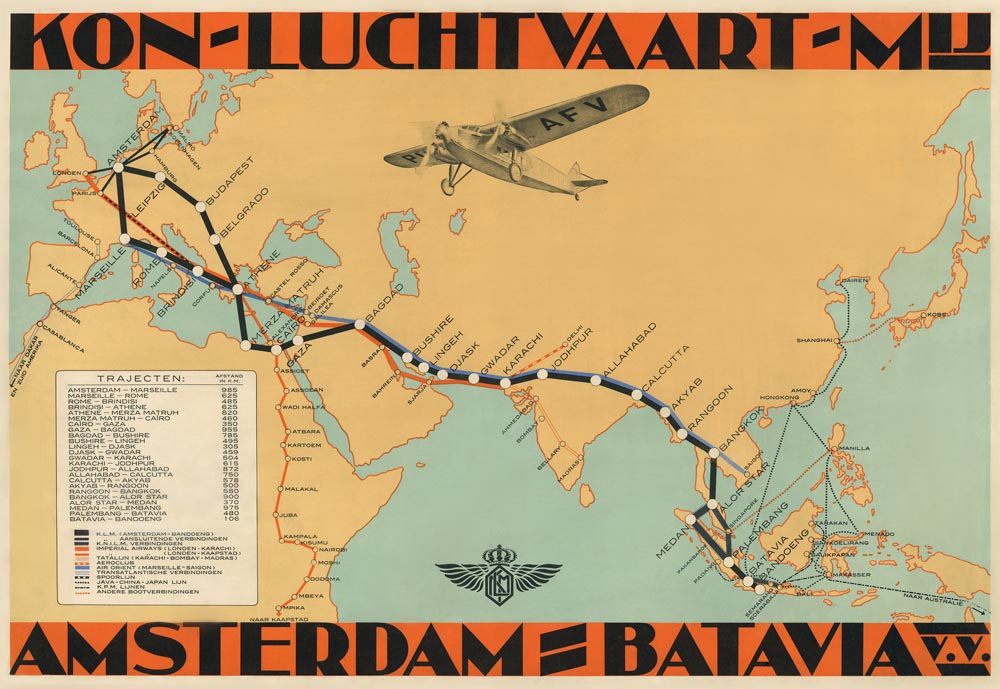Spanning over 17 thousand islands, Indonesia, the world’s largest archipelago, relies heavily on air travel for connectivity. With 683 airports facilitating over 500 thousand domestic flights annually and millions of travellers from abroad, aviation plays a vital role. Astonishingly, it’s just been exactly a century since the first European flight touched down in Indonesia. In this article, Sake Santema from Indies Gallery showcases early aviation advertisements from his collection and takes us on a short flight through the beginnings of air travel in and to this vibrant nation.

A circa 1930 advertisement poster showing the 14.350 km route from Amsterdam to Batavia (Jakarta). It took less than 1 week to reach the Dutch East Indies, compared to 6 weeks on a ship – this sure made a difference! (Indies Gallery Collection)
Early Explorations: A Pioneering Flight
On 1 October 1924, a remarkable chapter in Indonesia’s aviation history began as KLM (Koninklijke Luchtvaart Maatschappij) launched its first air expedition from Amsterdam to Batavia (Jakarta). Manned by a crew of three —a pilot, a co-pilot/navigator, and a mechanic— the journey took 55 days, crossing through 22 cities including Prague, Baghdad, Calcutta, Bangkok with the final stop in Batavia.This monumental flight was more than just a leap across continents; it was an adventure that showcased the potential of air travel.
Following this pioneering expedition, KLM embarked on a more direct venture in the years after, completing the journey to Batavia in just 10 days. After several successful test flights, the airline launched a regular service between Amsterdam and Batavia in 1930. Initially operating once a week, the service expanded quickly to three flights per week, landing at the Kemayoran Airport, Batavia. Before World War II, this was the world’s longest scheduled air service.
The Rise of KNILM: Connecting the Islands
In the context of Indonesia’s aviation growth, the establishment of the Koninklijke Nederlandsch-Indische Luchtvaart Maatschappij (KNILM) on July 16, 1928, marked a significant milestone. KNILM operated its first flights between Batavia and Bandung, and Batavia and Semarang, starting on November 1 of the same year. The airline didn’t stop there; it gradually expanded its network to include key destinations such as Surabaya, Palembang, Medan, Balikpapan, and Denpasar in Bali. With no established airstrips in certain regions, water landing aircrafts were deployed to serve towns like Ambon.
A New Era Post-Independence

Explore Bali’s timeless charm showcased in Garuda’s 1950 advertisement poster. In the early 1950s, just a handful of flights touched down on the island. Fast-forward to today and Bali has transformed into one of Indonesia’s most coveted destinations, welcoming approximately 400 daily flights. (Indies Gallery Collection)
Indonesia’s independence in 1945 brought significant changes to the aviation landscape. KNILM was disbanded and eventually nationalised by the Indonesian government, leading to the creation of Garuda Indonesia in 1949.
During the Dutch–Indonesian Round Table Conference in November 1949, Indonesian President Sukarno cited a poem by a renowned Javanese scholar and poet Raden Mas Noto Soeroto: “I’m Garuda, Vishnu’s Bird, that spreads its wings high above your Islands”. The name Garuda is taken from the Hindu tradition: it is the name of Lord Vishnu’s mount (vahana).
The first flight under the name Garuda Indonesian Airways was to pick up Sukarno in Yogyakarta on 28 December 1949. In 1956, the airline operated its first flight to Mecca carrying 40 Indonesian pilgrims. Garuda Indonesia quickly outgrew its initial focus on the Asian market and expanded its horizons, launching scheduled flights to Amsterdam and Frankfurt via Colombo, Bombay, and Prague beginning in 1965.
Trials and Triumphs
By the early and mid-1950s, the airline operated a fleet of 38 aircraft. Despite its growth, Garuda Indonesia faced significant challenges in the late 1990s. A series of tragic accidents, combined with the Asian financial crisis of 1997, plunged the airline into a difficult period. In 2007, the situation reached a critical point when the European Union imposed a ban on Garuda Indonesia and all Indonesian airlines from operating in European airspace. Thankfully, this ban was lifted in 2009: to-date Garuda Indonesia is the only Indonesian airline flying into Europe.
A Thriving Aviation Market
Today, Indonesia is recognised as a burgeoning market for air travel within the region. Between 2009 and 2017, the number of airline passengers soared from 27 million to an impressive 122 million, illustrating the growing demand for aviation services. As of 2023, the country boasted 54 scheduled and unscheduled commercial airlines.
The country is ranked as having the second-fastest growing aviation industry in the world after China in terms of aircraft order and business value. The International Air Transport Association (IATA) has predicted that Indonesia will become the world’s fourth largest air travel market by 2036. The future of aviation in Indonesia is set to be an exciting one.
The authentic posters in this article are available for purchase through Indies Gallery, while high-quality reprints can be found at Old East Indies.
Authentic Posters & Art: www.indiesgallery.com
High Quality Reprints: www.oldeastindies.com





